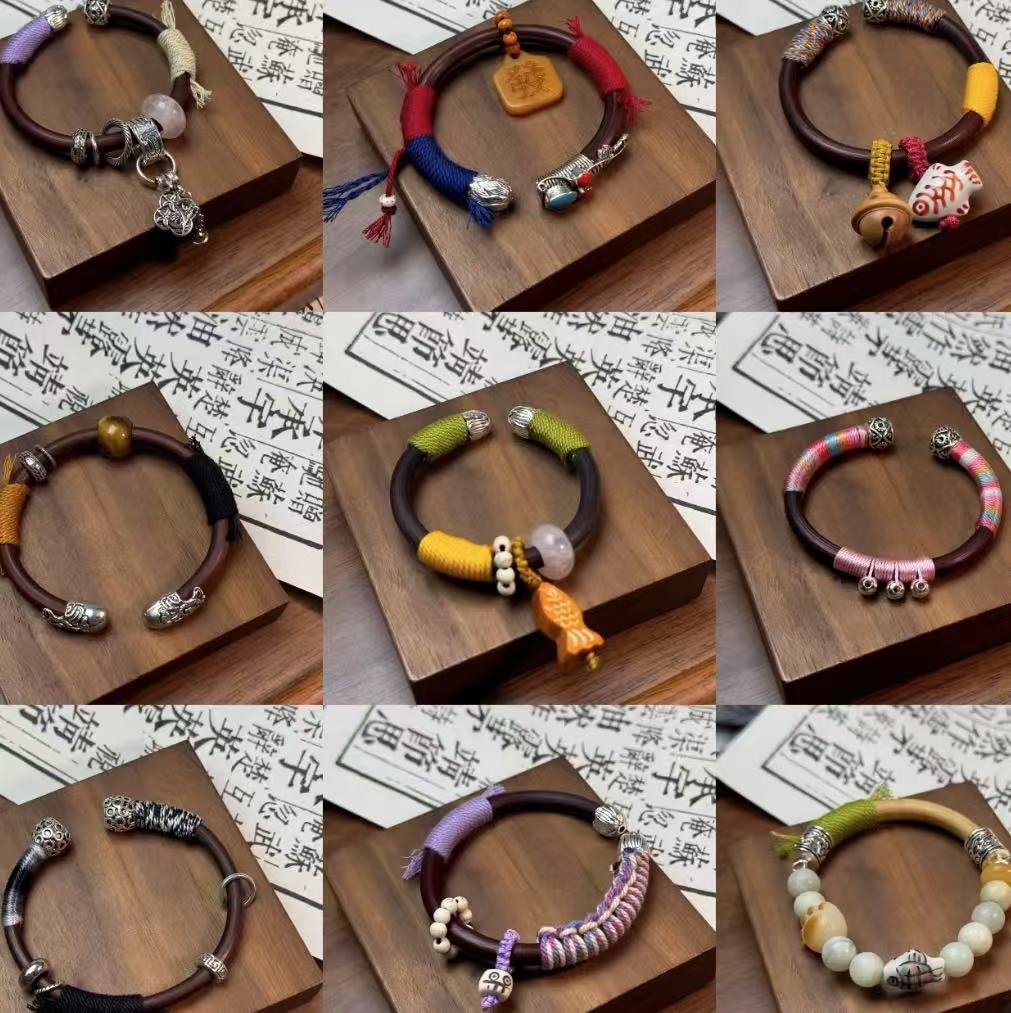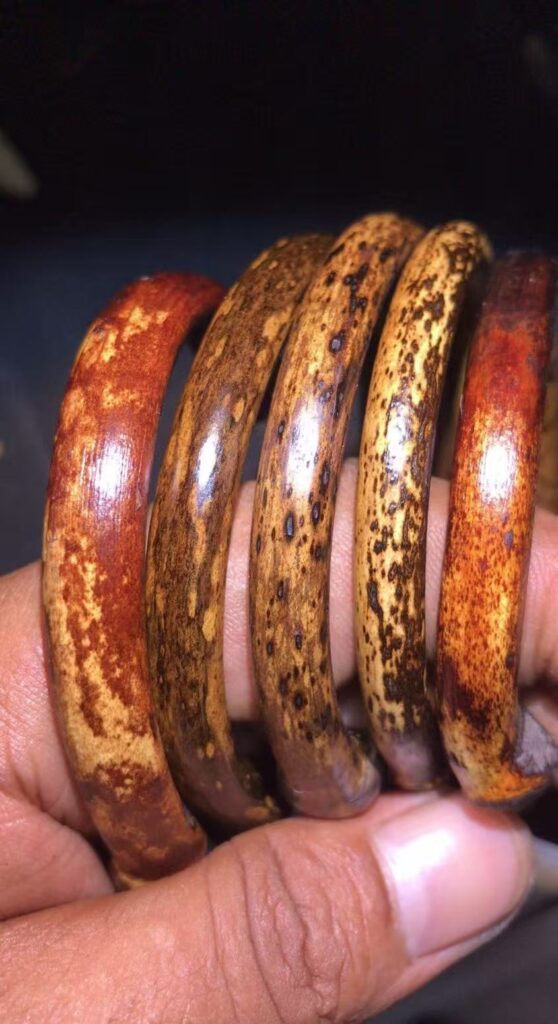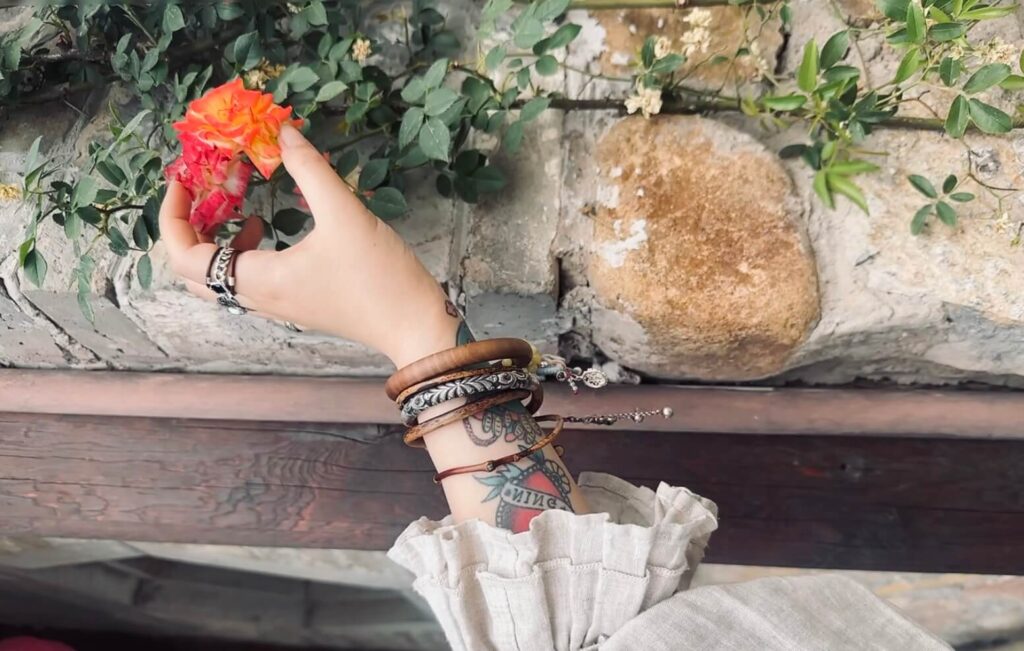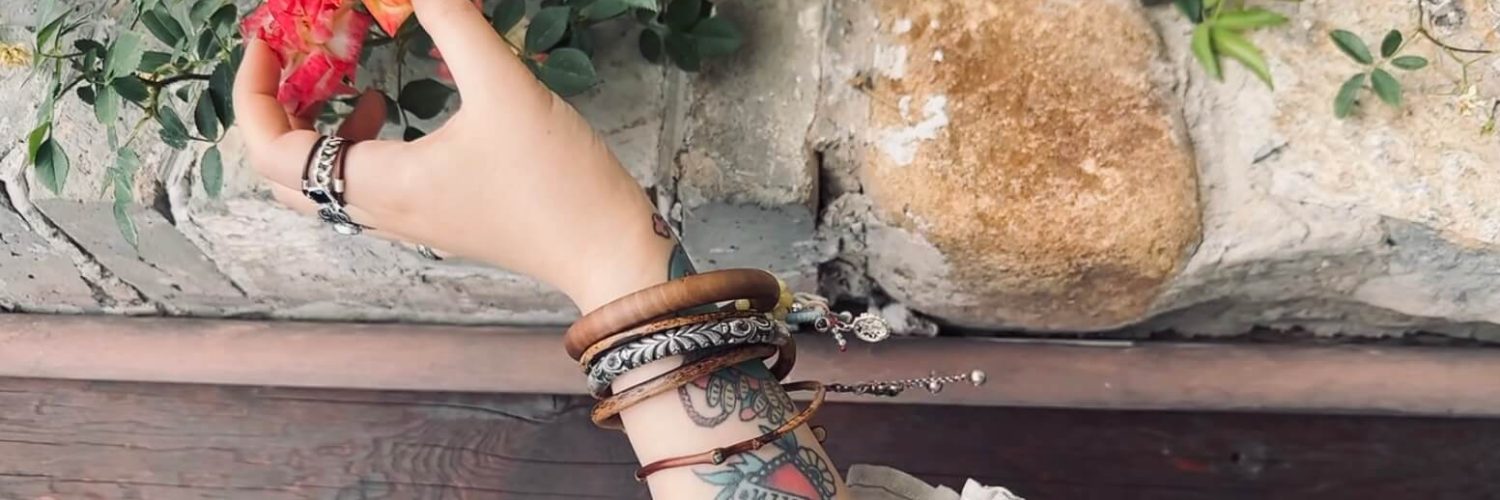Introduction: A Hidden Treasure in the World of Bangles
Many people may be unfamiliar with the Chicken Blood Vine Bangle. This is an ancient Tibetan jewellery made of the natural herb Caulis Spatholobi. Because it is produced in a mountain with an altitude of more than 4,000 meters, it has a long growth cycle and can only be picked for 2 months a year (the rattan picked from September to November is the most precious), so it is extremely precious. Legend has it that this natural herb is produced in the Dapa Shri mountain, which is known as the sacred mountain. People think that wearing something made from the sacred mountain is a treasure that will bring tranquillity and good fortune because it is fashioned from the mountain itself. Initially, the Caulis Spatholobi bangle was created because of its medical effect. Long-term use can help with rheumatism, joint discomfort, and even blood circulation and stasis removal, all of which are beneficial to the body.

Historical Background: From Ancient China to Modern Collections
According to research, vine bangle/bracelets appeared in the Song Dynasty hundreds of years ago, became popular in the Ming Dynasty, and reached their peak in the Qing Dynasty. However, due to the fragility of its own material, it is extremely difficult for people to see the full picture of the vine bangle before the Ming Dynasty. There are three main types of vine bracelets: traditional silver-wrapped rattan bracelets in the Han area, vine bracelets in the Nujiang River Basin in Yunnan, and Badu in Tibet.
According to historical records, people in different regions have different preferences for vine bangle/bracelets. In the Qing Dynasty, women in Zhejiang, Jiangsu, and Anhui liked to wear red rattan and wind rattan bangle. The reason is that wind vine and red vine are valuable, have therapeutic properties, and look beautiful. At that time, Yangzhou vine bangles were famous for their exquisite craftsmanship. From the late Qing Dynasty to the Republic of China, there was also a lacquer vine bracelet, which was said to be able to ward off evil and cure diseases. It was composed of sea willow or wood willow, and it was painted black after having holes bored in it and lead filled in. Very few of these Qing Dynasty lacquer vine bracelets remain today. During this period, there was also a kind of maple vine bracelet, which was actually made of single or multiple strands of creeper vines twisted into a bracelet. The multiple strands were called twisted bracelets. This kind of bracelet was usually wrapped with gold and silver at the joints. This kind of bracelet was cheap and also had the effect of reducing swelling and removing toxins, so it was more popular among ordinary people. Eileen Chang, a famous writer in the Republic of China, was a person who had a special liking for vine bracelets. She mentioned the vine bangle she wore many times in her literary works. The vine bangle bracelets mentioned above are all Han vine bangle bracelets.

Healing Benefits of Chicken Blood Vine Bangles in Traditional Chinese Medicine
Botanical origin: Caulis Spatholobi
Chicken Blood Vine, whose pharmacological name is Caulis Spatholobi, was first recorded in the Ming Dynasty’s “Ben Cao Bei Yao.” It is a rare vine plant that grows in areas above 4,000 meters above sea level. The pharmacopoeia records that Caulis Spatholobi is the dried vine stem of the leguminous plant Beans densiflora. It has the effects of promoting blood circulation, regulating menstruation and relieving pain, and relaxing muscles and tendons. It is called the “holy medicine for blood”. However, as a traditional Chinese medicine, the vine stems of Caulis Spatholobi are generally thicker, with diameters ranging from 2 to 15 cm, so it is not suitable for making vine bangel bracelets.
Alternative names: Chicken Blood Vine, Blood wind vine, Dragon’s Blood Vine
Chicken blood vine is usually named because its juice is as red as chicken blood. When cut, it will ooze out like blood. After drying, the vine will become hard, dark brown or black-red, and shiny. Therefore, it has many aliases such as big blood vine, blood wind vine, nine-layer wind, pig blood vine, red vine, blood dragon vine, etc.
Origin and Symbolic meaning
Tibet
Tibet is rich in vine bangle bracelets, which are a kind of decoration that more and more people know and love as Tibet is deeply developed. It is produced at the foot of the Dapa Shri mountain in Shannan. It was made by the lamas of Zhazhijijia Temple a long time ago. Wearing it on the wrist can relieve joint pain all over the body. There are small bumps every few centimeters on the Tibetan rattan bracelets, called “knots”. Tibetans believe that these knots are the incarnation of the dakini, and the dakini is the goddess representing compassion and wisdom. Therefore, in addition to decorative and medicinal effects, Tibetan rattan bracelets are also regarded as “amulets” to drive away evil and ensure safety.
Tibetan rattan bracelets have the simple and dignified beauty of “water lotus, natural without carving”, and are extremely spiritual and legendary, so they are widely favored by everyone. There is no authoritative research data to refer to the specific plant from which Tibetan rattan bracelets come. Because this kind of rattan bracelet can show a beautiful brown-red shiny color after long-term wearing, which looks like chicken blood, it is also commonly known as “chicken blood vine bracelet” by the locals.
Yunnan
In addition, Yunnan also produces the world-famous chicken blood vine. This vine has the phenomenon of “red dragon pulling out its beard and bleeding”, that is, when its stem is sawed off, a brown-red substance will seep out from the bast, like chicken blood, and it will turn black and shiny after solidification, which sounds a bit scary. The chicken blood vine mentioned here is the chicken blood vine that we often use as a blood-activating Chinese medicine.
However, the rattan bracelets that Yunnan ethnic minority women like to wear are not made of local chicken blood vine, but of a kind of red rattan. This red rattan is also extraordinary. It is said that it is collected from the deep mountains of Dananlika on the west bank of the Dulong River in Yunnan. It grows on the cliffs on the shady slopes of the mountains. It is a rare and unique red vine. Yunnan women wear this rattan bracelet to hint to outsiders that their men are brave and loyal to him.
Craftsmanship and Styles
The textures and styles of chicken blood vine bracelets are diverse.
Texture:
All kinds of patterns are available, such as tortoise shell pattern, green date pattern, leopard pattern (leopard dot pattern, leopard circle pattern), all-in-one colour, etc.
Style:
Natural polishing: retain the original texture of the vine
Wrapping: ethnic style wrapping, plus a variety of small accessories, inlaid beads,
Gold, silver or gemstone inlay: add decorative effect
Carved “big head” bracelet: carved lotus, phoenix or Tibetan pattern
With the changes of time and market, various forms have emerged, such as the splicing of various elements.

Points to note:
- Many of the tangled wires have some flaws on the back
- It is not recommended to buy spliced models, which are easy to deform and break. If you want to decorate, you can cut off the knots and add silver ornaments on both sides. They are usually glued with 502 glue. It is also easy to fall off after soaking in water for a long time. It is a normal phenomenon. Just glue it again if it falls off
- Tibetan silver ornaments will change colour over time. The ornaments on the market that look like 925 silver are not necessarily real.
Finally, the colour of chicken blood vine varies from reddish brown, straw yellow, and rare gold to purple, and even leopard or tortoise shell patterns. Red and dead grass yellow are more common. Black will become darker and darker after drying in the shade for a long time, and then the colour will deepen slightly after wearing for a long time. The black glass bottom leather is more expensive and looks good. Green is the colour just picked. The vine branches growing on the top will be dead grass yellow, orange, kumquat, and golden yellow after drying. There are fewer golden colours. The density of golden colour is generally not very good. The density is very expensive and too rare. Purple is also very popular. Some vines will develop a lustrous patina over time, becoming darker and smoother with wear.

How to choose a high-quality chicken blood vine bangle
When choosing a bracelet, pay attention to the following points:
- Texture: Smooth and full, without cracks, dents or worm holes
- High density: High-quality chicken blood vine is heavy, tough and difficult to bend
- Color: The darker and brighter the color, the higher the medicinal value
- Thickness: Most bangles are 5-7 mm thick, but high-quality bangles can be 7-10 mm thick
- Avoid choosing bangles with obvious damage, as they are prone to cracking or breaking during wear.
Frequently Asked Questions About Chicken Blood Vine Bangles
Q1: Are Chicken Blood Vine bangles good for health?
A: In traditional Chinese medicine, the vine is believed to improve blood circulation, relieve joint pain, and treat conditions like rheumatism. However, the chicken blood vine made into rattan bracelets has almost lost its medicinal properties, but many wearers report a sense of warmth and comfort over time.
Q2: How can I tell if a Chicken Blood Vine bangle is authentic?
A: Look for a dense, heavy feel; smooth surface; and rich natural color. Authentic pieces often come with a distinct earthy scent and visible vine patterns or joints.
Q3: Can I wear the bangle every day?
A: Absolutely. Daily wear is encouraged as it helps the bangle adapt to your wrist shape and develop a natural sheen. Just be careful to avoid soaking it or exposing it to extreme temperatures.
Q4: Why are these bangles rare and expensive?
A: The vine grows underground for over a decade before it can be harvested, and collection is limited by environmental laws. Combined with intricate handcrafting, this makes each piece unique and valuable.
Conclusion: More Than Just a Bangle
Beyond just being a piece of jewellery, the Chicken Blood Vine bangle represents healing, tradition, and the beauty of nature. With its centuries-old roots and ability to combine aesthetic appeal with therapeutic benefits, it is a unique yet potent illustration of the blending of handicraft and culture. This bangle has a specific position in the realm of traditional adornments, whether it is worn for its therapeutic properties, spiritual energy, or distinctive beauty.

